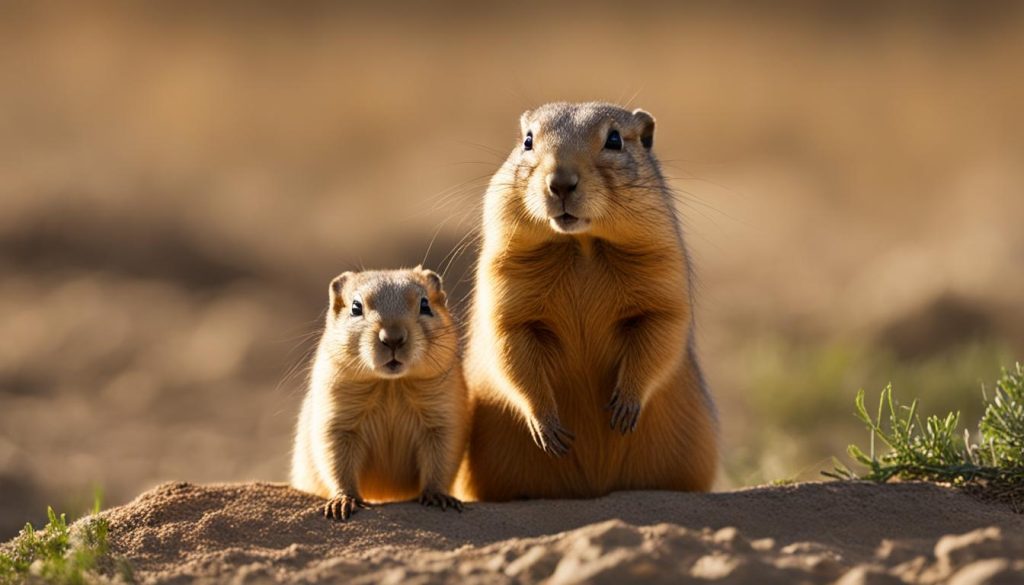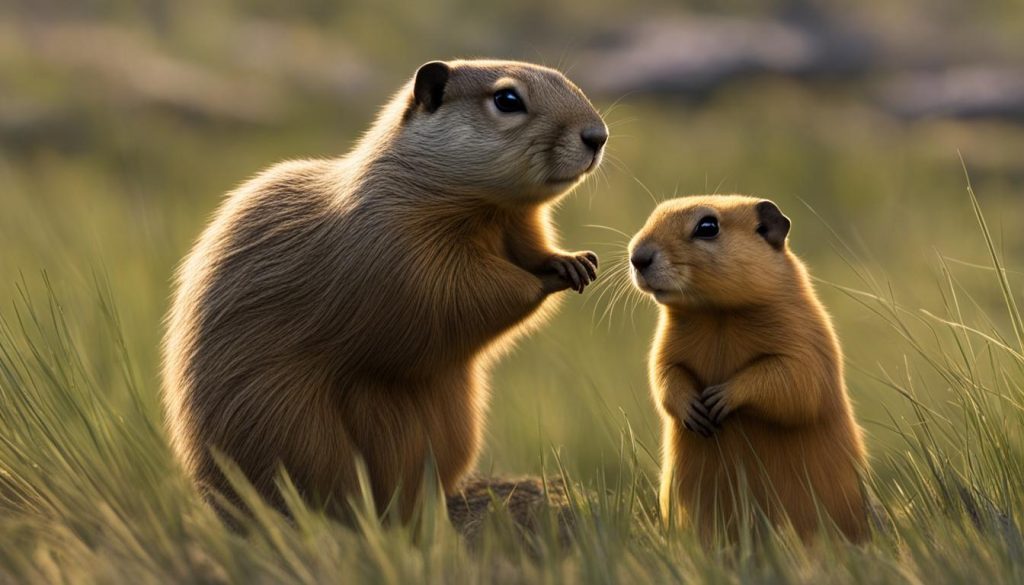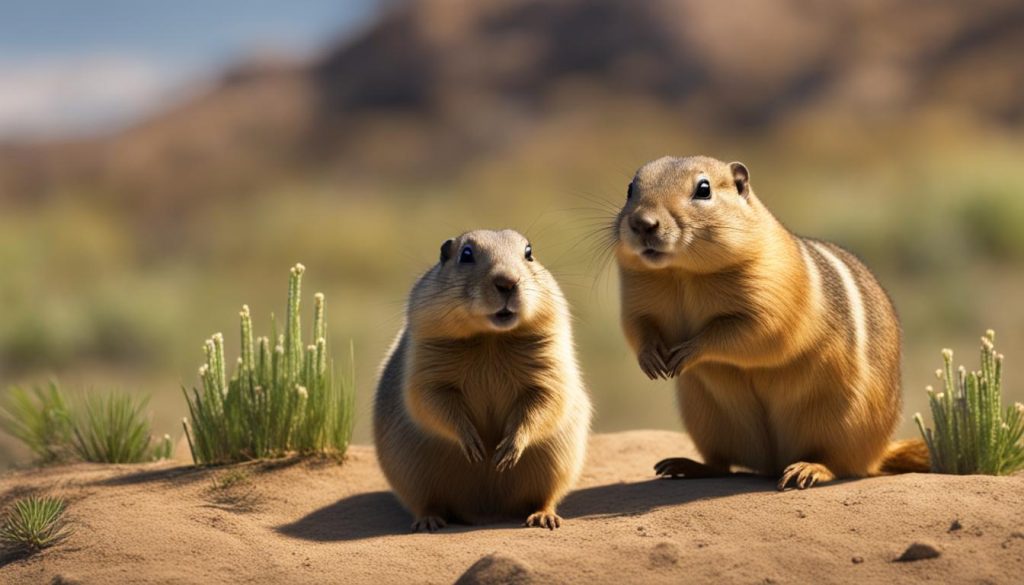When it comes to small rodents that burrow underground, gophers and prairie dogs may appear similar at first glance. However, there are distinct differences between these two creatures that set them apart. In this article, I will explore the contrasting features, behaviors, habitats, and diets of gophers and prairie dogs, allowing you to accurately identify and differentiate between these fascinating rodents.
Key Takeaways:
- Gophers and prairie dogs have different fur textures and colors, with gophers having smooth, pliable fur and prairie dogs sporting coarse fur with white or black accents.
- Gophers are solitary animals that spend most of their time underground, while prairie dogs live in social groups called towns and are active during the day.
- Gophers belong to the Geomyidae family, while prairie dogs are part of the Sciuridae family, which also includes squirrels.
- Gophers are smaller in size, measuring around 6 to 8 inches in length, while prairie dogs can reach lengths of 12 to 16 inches.
- The tails of gophers are longer and hairless, while prairie dogs have shorter, bushy tails.
Gophers and Prairie Dogs: Different Family Classifications
Gophers and prairie dogs may share similarities in appearance and habitat, but they belong to different families within the animal kingdom. Gophers are classified under the Geomyidae family, which includes at least 35 different species. On the other hand, prairie dogs are members of the Sciuridae family, which also encompasses squirrels. This distinction in family classification underscores the diverse evolutionary paths that these two rodents have taken.
While gophers and prairie dogs may look alike to an untrained eye, their family classifications reveal their unique genetic lineages. Gophers and prairie dogs have each adapted to their specific environments and developed distinct characteristics as a result. Understanding the differences between the Geomyidae and Sciuridae families helps in accurately identifying and categorizing these small mammals.

Gophers (Geomyidae Family)
- Belongs to the Geomyidae family
- Approximately 35 different species
- Characterized by long claws for digging
- Solitary animals, except during mating season
Prairie Dogs (Sciuridae Family)
- Belongs to the Sciuridae family
- Classified under the same family as squirrels
- Notable for their social behavior and living in groups
- Engage in various social activities within their towns
By examining the family classifications of gophers and prairie dogs, we gain insight into their evolutionary history and the unique traits that set them apart. This understanding is essential for accurately identifying and managing these small mammals in their respective habitats.
Gopher vs Prairie Dog: Size Differences
When comparing gophers and prairie dogs, one noticeable difference is their size. Prairie dogs are similar in size to rabbits, measuring between 12 and 16 inches in length. These small rodents have a compact and robust build, with a weight ranging from 1.5 to 3 pounds. In contrast, gophers are about half the size of prairie dogs, typically measuring around 6 to 8 inches in length. Gophers have a slender and cylindrical body, weighing between 0.25 to 0.5 pounds. Their smaller size allows them to navigate through narrow tunnels and burrows with ease.
Understanding the size differences between gophers and prairie dogs is crucial for accurate identification. These distinct sizes help distinguish between the two rodents, especially when observing them in their natural habitats.
To further highlight the difference in size, refer to the table below:
| Gopher | Prairie Dog |
|---|---|
| Size: 6 to 8 inches in length | Size: 12 to 16 inches in length |
| Weight: 0.25 to 0.5 pounds | Weight: 1.5 to 3 pounds |
As evident from the table, gophers are significantly smaller than prairie dogs, both in terms of length and weight. These distinctions in size play a crucial role in properly identifying and categorizing these two rodents.
Tail Characteristics of Gophers and Prairie Dogs
One of the distinguishing features between gophers and prairie dogs is their tails. Gophers have longer tails compared to prairie dogs, measuring up to two inches in length. These tails are typically hairless and have a more cylindrical shape. In contrast, prairie dogs have shorter and bushier tails that are covered in hair. The bushy tails of prairie dogs are often used to communicate with other members of their social groups.
The differences in tail characteristics serve different purposes for gophers and prairie dogs. The longer tail of the gopher helps it maintain balance and stability while digging intricate tunnel systems underground. The hairless nature of the gopher’s tail also prevents it from getting caught or tangled in the soil. On the other hand, the bushy tail of the prairie dog is used for communication and visual signaling within their social groups. It helps them convey different messages and warnings to other prairie dogs in the vicinity.
In summary, the tails of gophers and prairie dogs differ in length, texture, and function. While gophers have longer, hairless tails that aid in their underground activities, prairie dogs have shorter and bushier tails that facilitate communication within their social groups.
Habitat Differences between Gophers and Prairie Dogs
Gophers and prairie dogs are small rodents that inhabit different environments. Understanding their habitat preferences is crucial in distinguishing between the two species. Gophers are adaptable creatures that can survive in various habitats as long as there is sufficient vegetation and soil. They are commonly found throughout North and Central America, including fields, forests, and grasslands. Gophers create extensive tunnel systems underground, which provide them with protection and access to food sources.
Prairie dogs, on the other hand, have a more specific habitat requirement. They inhabit vast grasslands and prairies, where they form complex burrow systems known as towns. These towns consist of interconnected burrows that provide shelter, protection, and social interaction for the prairie dog community. They primarily occupy specific regions in North America, such as the Great Plains and the western United States. The unique habitat preference of prairie dogs reflects their ecological niche as highly social animals that rely on open grasslands for food and safety.
Table: Habitat Comparison between Gophers and Prairie Dogs
| Gophers | Prairie Dogs |
|---|---|
| Adaptable to various habitats | Specifically inhabit grasslands and prairies |
| Found in North and Central America | Primarily localized in specific regions of North America |
| Create extensive tunnel systems | Live in interconnected burrow systems called towns |
| Require sufficient vegetation and soil | Depend on open grasslands for food and safety |
Understanding the habitat differences between gophers and prairie dogs is essential for accurately identifying and managing these small rodents. By recognizing their preferred environments and the unique behaviors associated with their habitats, individuals can make informed decisions regarding conservation efforts and potential conflicts with human activities.
Gophers and Prairie Dogs: Contrasting Social Behavior
When it comes to social behavior, gophers and prairie dogs couldn’t be more different. Prairie dogs are known for their highly social nature, living in family groups called towns. Within these towns, prairie dogs engage in various social activities such as sharing food, grooming each other, and providing protection against predators. Their interconnected burrow systems create a complex social network where they communicate through a unique vocalization system, alerting others in the town about potential dangers.
“Prairie dogs are highly social creatures, living in family groups called towns.”
On the other hand, gophers tend to be solitary animals, preferring to live alone except during the mating season. They establish and maintain their own intricate tunnel systems, rarely interacting with other gophers. This solitary behavior is likely due to their territorial nature, as gophers mark their territories with scent glands and defend them vigorously against intruders. While gophers may occasionally encounter other gophers in their tunnels, their interactions are typically brief and limited.
These stark differences in social behavior between gophers and prairie dogs reflect the distinct lifestyles and interactions of these two rodent species. While prairie dogs thrive on communal living, gophers prefer the solitude of their underground tunnels.
Prairie Dog Social Behavior
Prairie dogs have complex social structures within their towns. They live in family groups led by an alpha male and female pair. These family groups are further organized into larger colonies where multiple families coexist. Within the colonies, different prairie dog families maintain their own territories and defend them against rival families. This social organization allows for cooperative behaviors such as communal defense against predators and resource sharing.
Furthermore, prairie dogs engage in vocal communication, using various calls to convey different messages. Their alarm calls, for example, serve as warning signals to alert other members of the group about potential threats. Prairie dogs also exhibit grooming behaviors, which enhance social bonds and contribute to overall group cohesion.
Gopher Solitary Behavior
Gophers, in contrast, are solitary animals that prefer to live alone. They establish their own territories, which they mark with scent glands, and defend them vigorously. Gophers are highly territorial and will aggressively defend their burrow systems against intruders. This territorial behavior ensures the availability of resources within their territory and reduces competition from other gophers.
Due to their solitary nature, gophers have minimal social interactions. They primarily communicate through scent marking and occasional encounters that occur while traversing their tunnel systems. During the breeding season, male and female gophers come together briefly for mating, but they do not form long-lasting social bonds or engage in cooperative behaviors like prairie dogs.
| Characteristic | Gophers | Prairie Dogs |
|---|---|---|
| Social Structure | Solitary | Highly social, living in family groups and colonies |
| Communication | Primarily through scent marking | Vocalizations, including alarm calls |
| Cooperative Behavior | Minimal | Communal defense, resource sharing, and grooming |
In summary, gophers and prairie dogs exhibit contrasting social behaviors. While prairie dogs live in highly social groups, engaging in cooperative behaviors and complex communication, gophers are solitary animals that prefer to live alone and defend their territories. These differences in social behavior contribute to the distinct lifestyles and interactions of gophers and prairie dogs.

Differences in Activity Patterns between Gophers and Prairie Dogs:
| Gophers | Prairie Dogs |
|---|---|
| Nocturnal | Diurnal |
| Primarily active at night | Most active during the day |
| Stay inside burrows during the day | Can be observed above ground |
Gopher vs Prairie Dog: Differences in Front Paws
When comparing gophers and prairie dogs, one distinct difference lies in their front paw characteristics. Gophers have long claws on their front paws that are specifically adapted for digging extensive tunnel systems underground. These sharp and sturdy claws enable gophers to efficiently excavate soil and create intricate burrows. In contrast, prairie dogs lack the long claws seen in gophers. Instead, their front paws are equipped with strong and muscular arms that assist them in their digging activities. The front paws of prairie dogs are more developed for the physical exertion required to create and maintain their interconnected burrow systems.
This variance in front paw anatomy highlights the contrasting burrowing behaviors of gophers and prairie dogs. While gophers excel at solitary digging, prairie dogs rely on a cooperative effort to construct their complex underground networks. The differences in front paw structure and function between these two rodents reflect their distinct adaptation strategies to suit their respective lifestyles and habitat requirements.
To summarize, gophers possess long claws on their front paws, specifically designed for efficient digging, while prairie dogs rely on strong and muscular arms for their burrowing activities. These differences in front paw characteristics contribute to the contrasting burrowing behaviors observed in these small rodents.
Table: Front Paw Characteristics of Gophers and Prairie Dogs
| Gopher | Prairie Dog |
|---|---|
| Long claws for digging | Strong and muscular arms for digging |
| Solitary burrow creation | Cooperative burrow construction |
| Efficient at excavating soil | Adapted for physical exertion |
Image source: seowriting.ai
Fur Characteristics of Gophers and Prairie Dogs
Gophers and prairie dogs possess distinct fur characteristics that help differentiate between the two rodents. Gophers have smooth fur, typically appearing in shades of dark brown, tan, or gray. This sleek fur enables them to navigate their underground tunnels with ease. On the other hand, prairie dogs have coarser fur, which is lighter brown in color. Additionally, prairie dogs often have white or black patches on their heads, adding to their unique appearance.
The variations in fur between gophers and prairie dogs serve multiple purposes. Gophers’ smooth fur helps to reduce resistance as they move through the soil, allowing for more efficient burrowing. In contrast, the coarser fur of prairie dogs provides insulation and protection from the elements in their open grassland habitats.
Recognizing these fur differences can be beneficial when identifying whether a burrowing rodent is a gopher or a prairie dog. By observing the texture, color, and presence of patches, individuals can accurately categorize and manage these small animals.

| Gophers | Prairie Dogs | |
|---|---|---|
| Fur Texture | Smooth | Coarse |
| Fur Color | Dark brown, tan, or gray | Light brown |
| Presence of Patches | No | White or black patches on head |
Gopher vs Prairie Dog: Diet Variations
When it comes to their diet, gophers and prairie dogs have distinct preferences. Prairie dogs primarily consume grass, seeds, flower buds, blossoms, fruit, and cacti as part of their herbivorous diet. On the other hand, gophers have a preference for tubers, bulbs, plant stems, and tree roots. These dietary differences reflect the specific ecological roles and food availability in their respective habitats.
The variation in diet between gophers and prairie dogs is a result of their distinct evolutionary adaptations. Prairie dogs have adapted to thrive in grasslands and prairies, where grasses and other vegetation are abundant. Their diet consists mainly of plant material found in their habitat. Gophers, on the other hand, inhabit a wider range of environments and have adapted to feed on underground plant parts, such as bulbs and roots, which provide them with the necessary nutrients for survival.
Understanding the dietary preferences of gophers and prairie dogs is crucial for their management and conservation. The availability of suitable food sources in their respective habitats directly influences their population size and overall ecological impact. By studying their diets, researchers and conservationists can gain insights into the specific nutritional requirements and adaptability of these rodents, contributing to effective strategies for their conservation and management.

Table: Diet Comparison between Gophers and Prairie Dogs
| Gophers | Prairie Dogs |
|---|---|
| Eat tubers, bulbs, plant stems, and tree roots | Consume grass, seeds, flower buds, blossoms, fruit, and cacti |
| Preference for underground plant parts | Primarily feed on plant material found in grasslands and prairies |
| Herbivorous diet | Herbivorous diet |
Gophers and Prairie Dogs: Overview and Comparison
Gophers and prairie dogs may share similar burrowing habits, but they have distinct differences that set them apart. Let’s take a closer look at the key characteristics of these two small rodents.
Appearance and Behavior
Gophers have smooth, pliable fur in colors like dark brown, yellow-brown, or gray. On the other hand, prairie dogs have coarse, light brown fur with white or black accents. Gophers have long claws on their front paws for digging, while prairie dogs have smaller incisors. When it comes to behavior, prairie dogs are highly social creatures that live in family groups called towns. Gophers, on the other hand, are solitary animals that prefer to live alone in their tunnels. These differences in appearance and behavior make it important to properly identify whether an animal is a gopher or a prairie dog.
Habitat and Activity Patterns
Gophers can be found throughout North and Central America and prefer to spend most of their time underground. They can survive in various habitats as long as there is sufficient vegetation and soil. Prairie dogs, on the other hand, live in specific areas of North America, mainly in vast grasslands and prairies. Prairie dogs are most active during the day and can often be observed above ground foraging for food. In contrast, gophers are rarely seen above ground during the day, as they prefer to stay inside their burrows.
Size, Tail Characteristics, and Diet
Size is another distinguishing factor between gophers and prairie dogs. Prairie dogs are similar in size to rabbits, measuring between 12 and 16 inches in length, while gophers are about half that size, typically measuring around 6 to 8 inches. Gophers have longer tails compared to prairie dogs, measuring up to two inches in length, and their tails have little to no hair. Prairie dogs, on the other hand, have shorter, bushy tails. In terms of diet, prairie dogs primarily eat grass, seeds, flower buds, fruit, and cacti, while gophers prefer to consume tubers, bulbs, plant stems, and tree roots.
Understanding the differences between gophers and prairie dogs is essential for accurately categorizing and managing these small animals. Whether it’s their appearance, behavior, habitat, or diet, each of these factors contributes to their unique identities in the animal kingdom.

Wrapping Up
To summarize, after a thorough examination of the characteristics, behavior, habitat, and diet of gophers and prairie dogs, it is clear that these two rodents have distinct differences that set them apart. While they may share some similarities in appearance and burrowing habits, the variations in size, tail characteristics, front paw anatomy, fur, social behavior, activity patterns, and dietary preferences make it crucial to properly identify whether an animal is a gopher or a prairie dog.
Gophers, with their smooth fur and long claws on their front paws, are solitary creatures that prefer to live in their underground tunnels. On the other hand, prairie dogs have coarse fur, shorter bushy tails, and strong arms for digging. They are highly social animals that live in family groups and are most active during the day. These differences in behavior and appearance are key indicators for proper identification.
Understanding the distinctions between gophers and prairie dogs is essential for effective management and conservation efforts. By accurately categorizing these small rodents, individuals can make informed decisions regarding their habitat, population control, and preservation. So, whether you come across a burrowing rodent, remember to carefully observe their characteristics to determine whether you’re dealing with a gopher or a prairie dog.
FAQ
What are the key differences between gophers and prairie dogs?
Gophers have smooth fur, long claws on their front paws, and are solitary animals. Prairie dogs have coarse fur, smaller incisors, and live in family groups called towns.
How do gophers and prairie dogs differ in size?
Prairie dogs are larger, measuring between 12 and 16 inches in length, while gophers are about half that size, typically measuring 6 to 8 inches in length.
What are the distinguishing tail characteristics of gophers and prairie dogs?
Gophers have longer tails without much hair, while prairie dogs have shorter, bushy tails.
What are the differences in habitat preferences for gophers and prairie dogs?
Gophers can survive in various habitats with sufficient vegetation and soil, while prairie dogs inhabit grasslands and prairies.
How do gophers and prairie dogs differ in social behavior?
Prairie dogs are highly social animals that live in family groups and engage in various social activities. Gophers, on the other hand, tend to be solitary animals except during the mating season.
What are the activity patterns of gophers and prairie dogs?
Gophers are mostly active underground during the day, while prairie dogs are active above ground during the day.
How do the front paw anatomy of gophers and prairie dogs differ?
Gophers have long claws on their front paws for digging, while prairie dogs lack the long claws seen in gophers.
What are the fur characteristics of gophers and prairie dogs?
Gophers have smooth fur in dark brown, tan, or gray colors, while prairie dogs have coarser fur in lighter brown with white or black patches.
How do the diets of gophers and prairie dogs differ?
Prairie dogs primarily eat grass, seeds, flower buds, fruit, and cacti, while gophers prefer tubers, bulbs, plant stems, and tree roots.
How can I properly identify whether an animal is a gopher or a prairie dog?
By considering differences in appearance, behavior, size, tail characteristics, habitat, social behavior, activity patterns, front paw anatomy, fur, and diet, you can accurately identify whether you are dealing with a gopher or a prairie dog.






